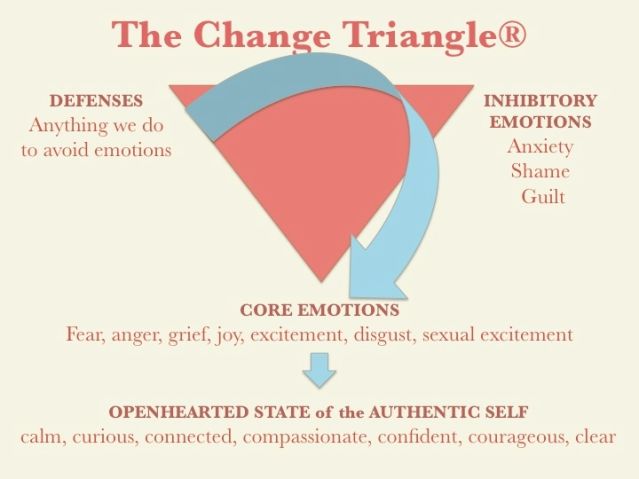KEY POINTS-
- Emotional health tools exist and are crucial for health and well-being.
- The Change Triangle explains how emotions move in the mind and body.
- Core emotions need to be named and validated for well-being.

The Change Triangle is a map—a guide to carry you from a place of disconnection back to your true self. Working the Change Triangle is the step-by-step process at the heart of accelerated experiential dynamic psychotherapy (AEDP), a therapeutic method that teaches patients to identify the defenses and inhibitory emotions (shame, anxiety, and guilt) that prevent us from being in touch with our core emotions (joy, anger, sadness, fear, and excitement). In allowing ourselves to fully experience core emotions, we move toward an openhearted state where we are calm, curious, connected, compassionate, confident, courageous, and clear.
When we first incorporate the Change Triangle into our daily lives, we have instant benefits:
1. Imparts immediate distance and perspective from our distress
Any time you notice you are distressed, upset, tight, avoidant, or engaging in regrettable behaviors, you can assume you are either having emotions or blocking them with emotional protection called defenses. This is the moment to visualize the Change Triangle. Try to figure out which corner most matches your current experience. Just remembering to think about where we are on the Change Triangle can stop a downward emotional spiral.
2. Brings awareness to the way our mind is working and if we are using defenses, experiencing inhibitory emotions, or experiencing core emotions
Once we see the Change Triangle on a piece of paper or in our mind’s eye, we can understand what’s happening to us emotionally. Here are the options:
- You might be using a defense to block your emotions. Defenses can trap us in our head. For example, you might notice you are ruminating or obsessing about being perfect. Or, we might fall into a depression, another way our mind shuts us down so we don’t feel our rage, grief, shame, or fear. Or, we might engage in hurtful behaviors like overeating or using drugs. Or, we might act out destructively in our relationships, even though we know better.
- You might be stuck in inhibitory emotions like anxiety, guilt, or shame, all of which deeply affect the body, which is why they are so uncomfortable. Inhibitory emotions have the ability to bury our core emotions, core needs, and core conflicts. Awareness of our inhibitory emotions is the first step to relief.
- You might be experiencing a core emotion such as sadness, anger, fear, or joy. Core emotions are very important to experience. But we need emotions education, skills, tools, and practice to reconnect safely with our core emotions, especially if we’ve been avoiding them our entire lives.
Our current state is located on one of the three corners of the Change Triangle—defenses, inhibitory emotions, or core emotions. Or we may find ourselves in a special place below the Change Triangle in the openhearted state of the authentic self.
- The openhearted state is a place in which we all want to spend more time. It feels great because in this state we can access calm, clarity, connection, curiosity, compassion, and confidence. We can handle whatever life brings. Working the Change Triangle over our lifetime helps us spend more time in the openhearted state of the authentic self.
3. Helps us figure out how to help ourselves feel better
Knowing which corner of the Change Triangle you are on is very important! It’s knowledge that tells us what needs to be done next to feel better. For example, if you recognize you are anxious, you will benefit by starting deep belly breathing to calm your body. Or, if we recognize we are in a defended state, we have the choice to stay there or reflect on the emotions we are running from.
4. Helps us find and name our core emotions
The brain calms down when we put language on our core emotions. By taking the time to slow down, scan your body for emotions, and put language on what you are experiencing, there is typically an immediate calming effect. Knowing the heavy feeling in your chest and pressure behind your eyes is sadness helps. Saying to yourself, I’m feeling sad, for example, calms the brain and regulates the body so it’s easier to release the sadness with a good cry.
5. Gets us in touch with the important data emotions provide so we can use that information on behalf of our well-being
Core emotions provide important data on how the world is affecting us so we can protect ourselves and help ourselves thrive. Just by noticing and naming your underlying core emotions, you are better situated to find out what they are telling you and how to use the information your emotions provide. For example, when you listen to and validate your anger, you can use it to set limits and say “No!” And, when you listen to and validate your sadness, you can take better care of your needs or reach out for comfort. Core emotions are designed by nature to be a compass for living.
Whether we work the Change Triangle alone as a self-help practice or we work it with a psychotherapist or counselor (yes, you can bring the Change Triangle or the It’s Not Always Depression book to your therapist), you will turbocharge your healing journey, find relief from your anxiety and depression, and gain clarity and connection with your authentic self.


